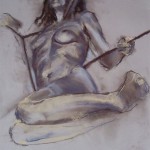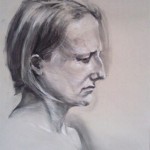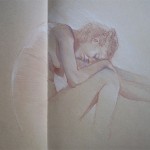LARA, one year on
A year is a milestone. An opportunity to reflect on my goals, progress and problems and plan for next year. There’s just one issue with that; I didn’t really have any sufficiently clear goals when I started this year, I just wanted to improve my drawing skills.
I did improve my drawing, I also learned other valuable lessons:
Lesson 1: Set some clear goals for next year.
That said, I also want to review some of the less tangible aspects of this year; how this experience has changed my ideas and approach to drawing, and my feelings about it.
So how did it go?
My drawing has definitely improved since this time last year. I’ve learnt skills that allow me to give my drawings far more solidity and a sense of depth and space. I’ve also learnt why these techniques work, as well as how to apply them, so I’ll be able to apply these ideas in other situations.
On another level it’s been a very difficult year for all sorts of other personal reasons. I won’t bore you with them but I do need to acknowledge them, ultimately it is not what happens but how I deal with it that matters.
Lessons 2 and 3: Acknowledge the problems and have confidence in my solutions.
Before and after drawings:
It is difficult to really compare before and after drawings but you know I’m going to anyway 🙂 so I have tried to match up drawings that are comparable by type or medium:
You can also see all of my LARA drawings here.
So what did I really learn?
I don’t think the before and after images reflect the full extent of what I’ve really learnt at LARA this year.
The images don’t show what I now understand, or what I learnt whilst making them; they are a record of mistakes and explanations. They document the results of the way that the process that is taught.
Studentship
It is impossible for me to relate atelier studies to the more modern teaching practices that I’ve experienced. They are so very different, that sometimes it’s difficult to be a student; to understand how to engage with the teaching, to grasp the basic dynamic of the ‘classroom’ and develop the connections necessary for personal and intellectual understanding.
The process taught is very structured, and the path so well trodden that it is hard to maintain a sense of perspective outside of the school environment. It is needed though, to ask the fundamental questions so necessary to real learning.
“Let a student enter a school with this advice: No matter how good the school is, his education is in his own hands. All education must be self-education…..A school should be an offering of opportunity, not a direction, and the student should know that the school will be good for him only to the degree that he makes it good…..The school is a place of strengths and weaknesses. There are things insisted upon and there are things omitted. The are all sorts of advices, good and bad, and there are advices that will serve one and not another….
The man who goes to school to educate himself and not to be educated will get somewhere. He should start out a master, master of such as he has, however little that may be. By being master of such as he has in the beginning, it is likely he may later be master, after years of study, of much.”
(Robert Henri)
Lesson 4: Maintain my own sense of direction and perspective.
The journey
It is hard to envisage now, since the atelier process is so consuming, that it is only one stop in a much longer and broader journey. The journey will contain many other stops, diversions, misdirections, deliberately wandering off the path and finding new paths as well as getting totally lost along the way. It is artistic, personal, professional, psychological and spiritual all at once and often indistinguishably. Good luck!




